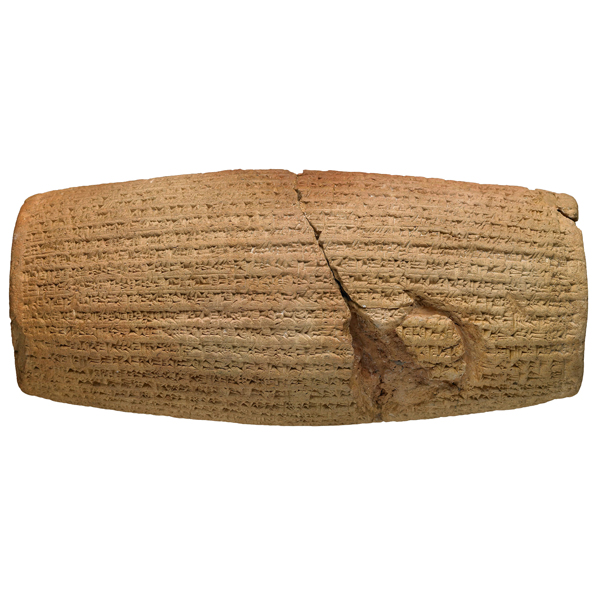 This clay cylinder is inscribed in Babylonian cuneiform with an account by Cyrus, king of Persia (559-530 BC) of his conquest of Babylon in 539 BC and capture of Nabonidus, the last Babylonian king.
This clay cylinder is inscribed in Babylonian cuneiform with an account by Cyrus, king of Persia (559-530 BC) of his conquest of Babylon in 539 BC and capture of Nabonidus, the last Babylonian king.
This cylinder has sometimes been described as the ‘first charter of human rights’, but it in fact reflects a long tradition in Mesopotamia where, from as early as the third millennium BC, kings began their reigns with declarations of reforms.
Cyrus Cylinder
From Babylon, southern Iraq. Babylonian, about 539-530 BC
A declaration of good kingship.
The British Museum
http://www.britishmuseum.org/explore/highlights/highlight_objects/me/c/cyrus_cylinder.aspx
Cyrus claims to have achieved this with the aid of Marduk, the god of Babylon. He then describes measures of relief he brought to the inhabitants of the city, and tells how he returned a number of images of gods, which Nabonidus had collected in Babylon, to their proper temples throughout Mesopotamia and western Iran. At the same time he arranged for the restoration of these temples, and organized the return to their homelands of a number of people who had been held in Babylonia by the Babylonian kings. Although the Jews are not mentioned in this document, their return to Palestine following their deportation by Nebuchadnezzar II, was part of this policy.
Cyrus Cylinder
http://www.livius.org/ct-cz/cyrus_I/cyrus_cylinder.html
Modern propaganda
The cylinder played an important role in the imperial propaganda of Shah Mohammad Reza Palavi, who in 1971 used it as symbol of the celebration of what he called the 2,500th anniversary of the Persian monarchy. A copy was given to the United Nations (text). The Shah tried to prove that the secular Iran with religious freedom that he wanted to promote had existed before, and in this context, the Cyrus Cylinder has been called the “world’s human rights charter”. This interpretation ignores the stereotypical nature of the document.
However, the idea that the Cyrus Cylinder plays a role in the history of human rights, has turned out to be quite persistent, and because the text itself does not enable the interpretation, a fake translation has been made that can still be found on many places on the internet and was, for instance, quoted by Shirin Ebadi when she accepted the Nobel Peace Prize in 2003. The fake translation can be recognized because the name of the supreme god, Marduk, is replaced by Ahuramazda, and because it contains lines like
I do not know the author of the falsification, but because the fake text is usually published after the text known as fragment-A, I suspect that it was made before fragment-B was discovered. I do not know what is more disturbing: that someone has made a falsification to prove the Shah’s propaganda, or that no university has put online the correct text to contradict this unpleasant fraud.
The transcript of the text offered on the next page has been adapted from the edition by Hanspeter Schaudig (below); the translation is based on Mordechai Cogan’s, published in W.H. Hallo and K.L. Younger, The Context of Scripture. Vol. II: Monumental Inscriptions from the Biblical World (2003, Leiden and Boston), but has been adapted to Schaudig’s edition with the help of Bert van der Spek.
(sk)
これが最初の人権宣言だという嘘を、いったい何回聞かされてきただろう。
そして、偽のテキストを、それも一字一句同じものを、何回見せられてきただろう。
プロパガンダはのなかではいつも、偽の情報が都合よく使われる。
プロパガンダは他のプロパガンダから情報を流用し、それが繰り返されるうちに偽の情報は正しい情報に化けていく。
偽の情報は、中東の権力者に使われ、ユダヤ人たちに使われ、人権を普及しようとする人たちによって使われてきた。
偽の情報を偽だという人の意見は、無視され続ける。